Two Dollar Radio Headquarters (HQ), a locally owned and operated family-run shop, is an indie bookstore, performance space, bar, coffeehouse, and fully vegan cafe located on South Side of Columbus, Ohio. Overview The $2 dollar bill is America's rarest small denomination in the US Currency. The unique history of the $2 bill has given the note an air of mystery and legend. If you have a $2 dollar bill in your wallet, it is always an instant conversation starter at parties and events where tipping is appropriate.
Burger King has announced a new meal deal. It contains one cheeseburger, 10 chicken nuggets, one medium fries, and a medium soft drink, all for $2 — a price that is so unfathomably low that it's. At Two Dollar Eats, our main goal is to save you money. We strive to provide you recipes that cost about $2 per serving, allowing you to eat delicious food while not breaking the bank! Click Below to Sign Up to our Mailing List to Receive Exclusive recipes like Tomato and Cream Manicotti.
Dollar2Dollars.com is a inexpensive quality online company that sell everything you can imagine at amazing deals.
The 1976 two dollar bill is a relatively old bill, but most of them aren't worth much more than their face value. However some bills can be worth more depending on a few different factors.
This was the year that the United States government re-issued the two dollar bill as a federal reserve note. Also called the Bicentennial Two, the 1976 two dollar bill was redesigned from the previous series. It has a much different look than the 1928 two dollar bill, the 1953 two dollar bill, and the 1963 two dollar bill.
Americans were interested in this bill because it had been a long time since paper currency was redesigned. Previous two dollar bill designs featured Jefferson's Monticello estate on the back of the bill. The back design now featured an image of the Declaration of Independence. In addition, the color scheme also changed. The bill now had a green seal instead of a red seal.
Specifications
| Denomination: | $2.00 U.S. Dollar |
| Type: | Federal Reserve Note |
| Seal Varieties: | One: Green |
| Series: | One |
Value
These bills aren't rare as many of them were printed- over a half billion. For this reason, most of them aren't valuable. If you have a regular circulated note then it will only be worth its face value of $2. If you have a note in uncirculated condition then it can sell for around $9-15.
It's possible to find bills with low serial numbers which are valued at a small premium. In addition, there are a few other factors that could raise the value of your bill. Below we will examine stamped bills, star notes, and a notable error bill.
Click here to search for 1976 2 dollar bills on Amazon.
Stamped Bills
The 1976 series was first issued out to the public on April 13th, 1976. People who received first day issues went to their local post office so they can get their bills stamped with the date. The value is slightly higher for stamped bills and stamps with unique city names.
Star Notes
Star notes are replacement notes that have a star before the serial number. There are both common star notes and rare star notes. What separates them is the federal reserve bank from which they were printed from. These bills were printed from 12 different federal reserve banks and two of them are rare. The Federal Reserve Bank of Kansas City and the Federal Reserve Bank of Minneapolis are the rare varieties that you should be looking for. You can check your own bill by looking on the front left hand side to see the issuing bank's name.
The common variety 1976 $2 star notes are worth around $8 in fine condition. In uncirculated condition the price is around $20-25 for bills with an MS 63 grade. The rare variety star notes can sell for around $80 in fine condition and around $150 in uncirculated condition with a grade of MS 63.
1976 Two Dollar Error Bill
There is one notable error for this series, but it's not immediatly noticeable. On each individual paper currency there is a serial number which is shown in two places on the front: the top right and the bottom left. Normally the serial number is the same in both places, but on the error bill the serial numbers are different. In most cases one of the prefixes will be different on the error bill. This was a printing error.
This two dollar error note is worth around $400 in very fine condition. In uncirculated condition the value is around $800.
Grading System
Fine- A note that shows clear evidence of having been in circulation. The note has lost its crispness and its very fine detail. The note has creases but there are no stains.
Very fine- A note that has been in circulation but not for a long time. The note is still relatively crisp. There may be some creases, folds, or light smudges.
MS 63 choice uncirculated- A note that shows no signs of ever having been in circulation. The note still has its original crispness. The note is also well-centered.
Conclusion
Vegas strip blackjack games. Most people realize that the 1976 two dollar bill isn't quite old enough to become a valuable item. But what most people don't realize is that this bill can be valuable if it has a unique stamp, if it's a rare star note variety or if it's an error bill. Valuable bills should be placed inside protective currency holders.
Sources:
/US0200-Two-Dollar-Bill-series-2003-A-d124f796303247cb8771087fbb98065c.jpg)
The US Dollar is the currency of United States. Our currency rankings show that the most popular United States Dollar exchange rate is the USD to EUR rate. The currency code for Dollars is USD, and the currency symbol is $. Below, you'll find US Dollar rates and a currency converter. You can also subscribe to our currency newsletters with daily rates and analysis, read the XE Currency Blog, or take USD rates on the go with our XE Currency Apps and website. More info ►
Top USD Exchange Rates
Currency Facts
Name: US Dollar

Symbol: $ cent: ¢
Minor Unit:
1/100 = cent
Central Bank Rate: 2.00
Top USD Conversion:
USD/EUR
2 Dollar Bill

Top USD Chart:
USD/EUR Chart
152 Images featuring Joker (Prime Earth). Inflation: 2.10%
Nicknames:greenback, buck, green, dough, smacker, bones, dead presidents, scrillas, paper

Coins:
Freq Used: 1¢, 5¢, 10¢, 25¢
Rarely Used: $1, 50¢
Banknotes:
Freq Used: $1, $5, $10, $20, $50, $100
Rarely Used: $2
Central Bank:
Federal Reserve Bank
Website: http://www.federalreserve.gov
Users: United States, America, American Samoa, more ..
Have more info about the US Dollar?Email us ►
2 Dollar Bill Value
XE Currency Converter
Why are you interested in the USD?
US Dollar History
The US central bank is called the Federal Reserve Bank (commonly referred to as 'The Fed'). The USD is the most traded currency in the forex market and can be paired with all other major currencies. Common names for the USD include the greenback, buck, green, dough, smacker, bones, dead presidents, scrillas, and paper.
Importance of the US Dollar
The US Dollar is the most commonly converted currency in the world and is regularly used as a benchmark in the Forex market. As the dominant global reserve currency, it is held by nearly every central bank in the world. Additionally, the Dollar is used as the standard currency in the commodity market and therefore has a direct impact on commodity prices.
Dollarization of the USD
Due to its international acceptance, some countries like Panama and Ecuador use the USD as an official legal tender, a practice known as dollarization. For other countries the Dollar is an accepted alternative form of payment, though not an official currency for the country. Multiple currencies are pegged to the US Dollar:
| Country | Peg Rate |
| Aruban or Dutch Guilder | 1.79000 |
| Bahamian Dollar | 1.00000 |
| Bahraini Dinar | 0.37690 |
| Barbadian Dollar | 2.00000 |
| Belizean Dollar | 2.00000 |
| Bermudian Dollar | 1.00000 |
| Cayman Island Dollar | 0.82000 |
| Cuban Convertible Peso | 1.00000 |
| Djiboutian Franc | 177.721 |
| Dutch Guilder | 1.79000 |
| East Caribbean Dollar | 2.70000 |
| Eritrean Nakfa | 15.0000 |
| Hong Kong Dollar | 7.80000 |
| Jordanian Dinar | 0.70900 |
| Lebanese Pound | 1507.50 |
| Omani Rial | 0.38450 |
| Panamanian Balboa | 1.00000 |
| Qatari Riyal | 3.64000 |
| Saudi Arabian Riyal | 3.75000 |
| United Arab Emirati Dirham | 3.67250 |
| Venezuelan Bolivar | 6.30000 |
Introduction of the US Dollar
In 1785, the Dollar was officially adopted as the money unit of the United States. The Coinage Act of 1792 created the first U.S. Mint and established the federal monetary system, as well as set denominations for coins specified by their value in gold, silver, and copper. In 1861, the U.S. Treasury issued non-interest-bearing Demand Bills and the very first $10 Demand Bills, featuring Abraham Lincoln, went into circulation. These bills quickly earned the nickname 'Greenbacks' because of their color. In 1863, a national banking system was established and guidelines for national banks were created. These banks were authorized to issue national currency secured by the purchase of US bonds. In 1914, the first $10 Federal Reserve notes were issued.
Silver and Gold Standard in the US
For years, the United States attempted to make a bimetallic standard, starting by adopting a silver standard based on the Spanish Milled Dollar in 1785. However, silver coins soon left circulation becoming completely suspended by 1806. By this time, most countries had already begun to standardize transactions by adopting the gold standard, meaning that any paper money could be redeemed by the government for its value in gold. The Bretton-Woods system was adopted by most countries to set the exchange rates for all currencies in terms of gold. Since the United States held most of the world's gold, many countries simply pegged the value of their currency to the Dollar. Central banks maintained fixed exchange rates between their currencies and the Dollar, turning the US Dollar into the de facto currency of the world. In 1973, the US finally decoupled the value of the Dollar from gold completely.